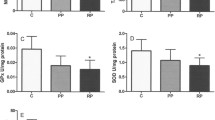Abstract
Purpose
To determine the concentration of the trace elements iron, copper, and zinc in pterygium tissue and healthy conjunctiva tissue and to investigate the involvement of these elements in pterygium etiopathogenesis.
Methods
Twenty patients with pterygium were enrolled in the study. The pterygium was excised and a conjunctival rotational flap or autograft inserted. Normal conjunctiva tissue was obtained from the flap or graft. The concentrations of iron, zinc, and copper in the pterygium and conjunctiva tissues were determined by atomic absorption spectrometry after microwave digestion.
Results
Iron, zinc, and copper levels were significantly higher in the pterygium tissue than in the normal conjunctiva (P < 0.001). The mean iron, zinc, and copper concentrations in the pterygium tissue were 819, 214, and 3.40 μg/g, whereas the mean concentrations of these elements in the control tissue were 491, 148, and 2.19 μg/g, respectively.
Conclusions
Pterygium is a fibrovascular proliferative disorder and elevated levels of trace elements in pterygium tissue may play a pathogenic role via oxidative damage.

Similar content being viewed by others
References
Qing-feng L, Liang XU, Qi-sheng YQ, **ao-hui Y, Tong-tong C. Epidemiology of pterygium in aged rural population of Bei**g, China. Chin Med J. 2010;123:1699–701.
Shiroma H, Higa A, Sawaguchi S, Iwase A, Tomidokoro A, Amano S, et al. Prevalence and risk factors of pterygium in a southwestern island of Japan: the Kumejima study. Am J Ophthalmol. 2009;148:766–71.
Marcovich AL, Morad Y, Sandbank J, Huszar M, Rosner M, Pollack A, et al. Angiogenesis in pterygium: morphometric and immunohistochemical study. Curr Eye Res. 2002;25:17–22.
Balcı M, Şahin S, Mutlu FM, Yagcı R, Karancı P, Yıldız M. Investigation of oxidative stress in pterygium tissue. Mol Vis. 2011;17:443–7.
Jomova K, Vondrakova D, Lawson M, Valko M. Metals, oxidative stress and neurodegenerative disorders. Mol Cell Biochem. 2010;345:91–104.
Jomova K, Valko M. Advances in metal-induced oxidative stress and human disease. Toxicology. 2011;283:65–87.
Songur A, Kus İ, Şahin S, Söğüt S, Ozen OA, Yaman M, et al. The changes of zinc, copper and iron levels in lung tissue after formaldehyde inhalation during the early postnatal period of rats. Eur J Gen Med. 2005;2:62–8.
Gupte A, Mumper RJ. Elevated copper and oxidative stress in cancer cells as a target for cancer treatment. Cancer Treat Rev. 2009;35:32–46.
Rajendran R, Minqin R, Ynsa MD, Casadesus G, Smith MA, Perry G, et al. A novel approach to the identification and quantitative elemental analysis of amyloid deposits—insights into the pathology of Alzheimer’s disease. Biochem Biophys Res Commun. 2009;382:91–5.
Loh A, Hadziahmetovic M, Dunaief JL. Iron homeostasis and eye disease. Biochim Biophys Acta. 2009;1790:637–49.
Prousek J. Fenton chemistry in biology and medicine. Pure Appl Chem. 2007;79:2325–38.
Gebhardt M, Mentlein R, Schaudig U, Pufe T, Recker K, Nölle B, et al. Differential expression of vascular endothelial growth factor implies the limbal origin of pterygia. Ophthalmology. 2005;112:1023–30.
Bradley JC, Yang W, Bradley RH, Reid TW, Schwab IR. The science of pterygia. Br J Ophthalmol. 2010;94:815–20.
Stadler N, Lindner RA, Davies MJ. Direct detection and quantification of transition metal ions in human atherosclerotic plaques: evidence for the presence of elevated levels of iron and copper. Arterioscler Thromb Vasc Biol. 2004;24:949–54.
Haidari M, Javadi E, Kadkhodaee M, Sanati A. Enhanced susceptibility to oxidation and diminished vitamin E content of LDL from patients with stable coronary artery disease. Clin Chem. 2001;47:1234–40.
Dunaief JL. Iron induced oxidative damage as a potential factor in age-related macular degeneration. Invest Ophthalmol Vis Sci. 2006;47:4660–4.
Murrel TG. Epidemiological and biochemical support for a theory on the cause and prevention of breast cancer. Med Hypotheses. 1991;36:389–96.
Huang YL, Sheu JY, Lin TH. Association between oxidative stress and changes of trace elements in patients with breast cancer. Clin Biochem. 1999;32:131–6.
Bray TM, Bettger WJ. The physiological role of zinc as an antioxidant. Free Radic Biol Med. 1990;8:281–91.
Lee SJ, Koh JY. Roles of zinc and metallothionein-3 in oxidative stress-induced lysosomal dysfunction, cell death, and autophagy in neurons and astrocytes. Mol Brain. 2010;3(1):30.
Di Giriloma N, Wakefield D, Coroneo MT. Differential expression of matrix metalloproteinases and their tissue inhibitors at the advancing pterygium head. Invest Ophthalmol Vis Sci. 2000;41:4142–9.
Author information
Authors and Affiliations
Corresponding author
About this article
Cite this article
Ortak, H., Demir, H.D., Mendil, D. et al. Evaluation of iron, zinc, and copper levels in pterygium tissue. Jpn J Ophthalmol 56, 219–223 (2012). https://doi.org/10.1007/s10384-012-0118-7
Received:
Accepted:
Published:
Issue Date:
DOI: https://doi.org/10.1007/s10384-012-0118-7




